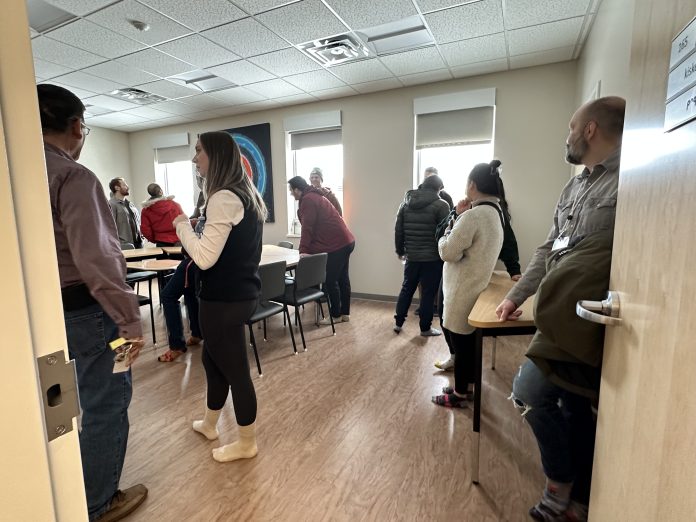
A group of 20 medical students and medicine residents toured health facilities, organized through the Saskatchewan Medical Association’s Roadmap Program (SMA) in La Ronge Saturday, April 1.
The program is designed to increase “the number of locally trained physicians working in smaller communities, according to a SMA news release dated March 31, 2023.
The students have an opportunity to see first-hand various health facilities and “learn about real and regional health care from local physicians.”
Dr. Sean Groves, a La Ronge physician and chair of the SMA’s Committee on Rural and Regional Practice (CORRP) accompanied the group on the tour. CORRP supports the Roadmap Program.
The program is important with “fewer medical students choosing to work in family medicine,” quoted from the news release.

“There is a crisis in family medicine. The solutions are multi-faceted and complex, but the Road map Program is one tool CORRP can support that aims to make a difference in rural health care, … The roadmap Program acquaints medical students to the diversity of care that rural physicians provide their patients. I know from experience the challenges are many, but so too are the rewards. Hopefully medical students come away from the experience contemplating a career in rural family medicine,” Groves is quoted as saying in the news release.
He also spoke to the group gathered about the benefits of learning different types of medical and healthcare practices with the diversity found across Saskatchewan.
Eriq Marleau is a first-year medical student, who is interested in going into family medicine.
“I think it’s a really great experience to have to see rural location practices, being primarily based in Saskatoon and Regina to see, (and) not only rural spaces, but northern rural and places with a greater Indigenous population that have the capacity. That is going to make an amazing amount of help. It’s really cool that this exists.,” Marleau said.
He was particularly interested in the Woodland Treatment Centre programming and “we could implement this in other places as well.”
The group toured Churchill High School, the nursing program centre and the Woodland Treatment Centre and others.
“This has definitely been the highlight, the Woodland Wellness Centre,” Marleau said. “It’s an amazing effort by the community to fill this need and promote wellness in an Indigenous lens. I think it’s going to help a lot of people. It’s a really cool perspective for us to see cause we’re exposed to the western model … introducing the Indigenous practices as well is really important to serve all of our patients.”
Along with the La Ronge tour, Marleau said, he’s been to Estevan, Swift Current and North Battleford through the Roadmap Program.
Jessica Froehlich is about to start her second-year residency, which she plans to do in La Ronge.
Froehlich spent time in La Ronge during her earlier training and wanted to come back. She will begin her residency at the beginning of June and will be here for a full year, where she will complete her training, do a “big exam” and become a full-fledged doctor.
“I came up to La Ronge to do some of my training and I loved it so much that I decided to do my family medicine residency training here. I’m a first-year resident. Have been in La Ronge for the first six months and right now I’m doing some training in Regina. So that gives me exposure to like, acute care, critical care and acute procedures we can use in rural or remote medicine,” Froehlich said in an interview with the Northern Advance.
The journey to becoming a doctor includes four years in university and two years, in her case, of residency.
Froehlich said she got “a lot out of this program,” as a student and it feels good to her to be on the other side, being able “to give back a little bit.” The tour was a one-day journey to and from Regina and was packed with much experience for the group.

